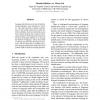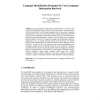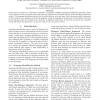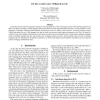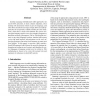125
click to vote
CLEF
2011
Springer
14 years 14 days ago
2011
Springer
This paper describes the participation of UAIC team at the LogCLEF 2011 initiative, language identification task. Our approach is an aggregation of known methods for recognizing la...
124
click to vote
LREC
2010
14 years 7 months ago
2010
There are many accurate methods for language identification of long text samples, but identification of very short strings still presents a challenge. This paper studies a languag...
105
Voted
NAACL
2010
14 years 10 months ago
2010
Language identification is the task of identifying the language a given document is written in. This paper describes a detailed examination of what models perform best under diffe...
109
Voted
NAACL
2010
14 years 10 months ago
2010
The task of identifying the language of text or utterances has a number of applications in natural language processing. Language identification has traditionally been approached w...
107
click to vote
ENGL
2008
15 years 22 days ago
2008
Language Identification (LID) refers to the task of identifying an unknown language from the test utterances. In this paper, a new method of feature extraction, viz., Teager Energy...
112
click to vote
CLEF
2010
Springer
15 years 1 months ago
2010
Springer
In our participation to the 2010 LogCLEF track we focused on the analysis of the European Library (TEL) logs and in particular we experimented with the identification of the natura...
119
click to vote
CLIN
2001
15 years 2 months ago
2001
Two major stages stages in language identification systems can be identified: the language modeling stage, where the distinctive features of languages are determined and stored in...
101
click to vote
LREC
2008
15 years 2 months ago
2008
In this paper we present two experiments conducted for comparison of different language identification algorithms. Short words-, frequent words- and n-gram-based approaches are co...
94
Voted
LREC
2010
15 years 2 months ago
2010
As the data for more and more languages is finding its way into digital form, with an increasing amount of this data being posted to the Web, it has become possible to collect lan...
111
Voted
CIMCA
2006
IEEE
15 years 2 months ago
2006
IEEE
Existing Language Identification (LID) approaches do reach 100% precision, in most common situations, when dealing with documents written in just one language, and when those docu...

